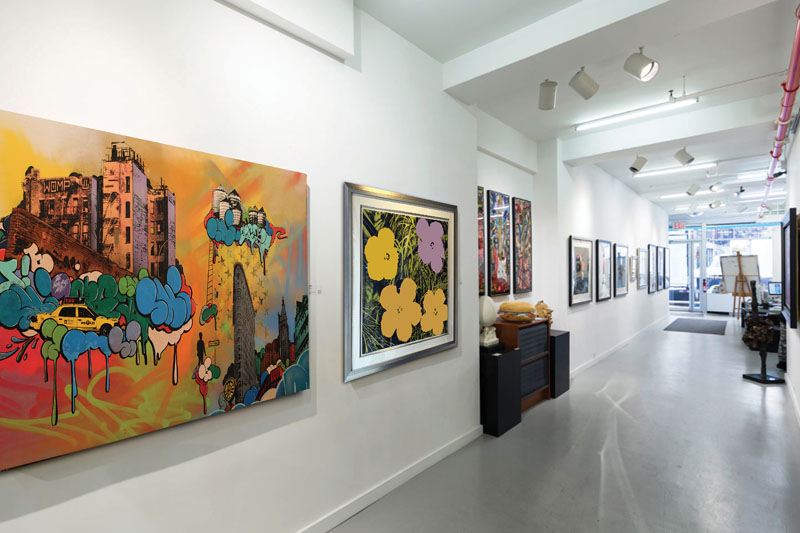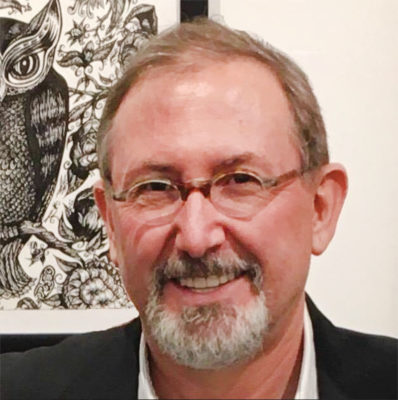
When artists began the pop art movement, the goal was to get away from the conventional, highbrow themes that had dominated the art world for so long. Rather, the movement sought to blur the lines between “high art” and “low culture,” putting the spotlight on household objects and pop culture figures.
It was art for everyone and it takes centerstage at Pop International Galleries, a space dedicated to iconic artists such as Keith Haring, Andy Warhol and Roy Lichtenstein, as well as up-and-coming artists in the pop art scene.
“Pop art was the last real art movement, but now we have this art that everybody is looking at, street art and graffiti art,” said Pop International Galleries owner Jeff Jaffe. Inside Pop International, guests can view a $1.2 million Andy Warhol next to a $1,200 print by an unknown artist. “The idea is to show people that they are direct connections. Just like everyone can identify with Andy Warhol, people can see graffiti art on a canvas and say, ‘this looks like something I saw on a wall in Brooklyn.’”
The secret to finding an up-and-coming artist worthy of gallery space? Well, that’s the million-dollar question, notes Jaffe. But with decades of gallery work under his belt and an even longer career as an artist, Jaffe has a keen eye for talent.
Though Jaffe’s love of art began after winning a drawing competition at the ripe age of 3 years old, it was refined through a lifetime of unusual circumstances.
Growing up in apartheid-era South Africa, Jaffe had few opportunities to explore his artistic passions and reluctantly joined his male counterparts in being drafted to the military after high school graduation.

Jaffe was an unwilling participant in the special services battalion, eventually working for the military newspaper where he illustrated cartoons and wrote articles. His politically incorrect works soon landed him in trouble and the 18-year-old found himself facing multiple charges. The charges were eventually dropped and Jaffe finished his service working in a military museum, making backdrops and displays.
It was a much more fitting environment for Jaffe, who left South Africa 10 days after finishing his military service to live in Israel and study sculpture. A professor at the university suggested his abilities would be better fostered in the United States, and Jaffe, with only $100 and a student visa in his pocket, came to America, studying at Montclair College and then the prestigious Cranbrook Academy of Art.
While Jaffe had left South Africa behind, his artwork revealed just how much his native country had influenced his work.
“I remember the president of Cranbrook Academy, he looked at my work and said ‘ah, the art of protest.’ It was protest art,” said Jaffe. Now an American citizen, the artist finds his influences in American politics and society. “The work I make for myself is still very much about propaganda and that political influence plays an important part. [My art] has always been very connected to that world of resistance and politics.”
Being an artist has allowed Jaffe a distinct advantage as owner of Pop International Galleries, which he opened in 1997. For Jaffe, being a gallery owner isn’t about turning a profit, it’s about fostering a relationship with the artist.
“I see myself in many of the people that come to me. I have a certain intrinsic empathy, having been an artist and going to art school and experiencing the notion of what it’s like to make things and just dying for good representation in an art gallery,” said Jaffe. “For me, there’s a certain symbiosis. I get quite emotional and a relationship is born and the lives of the artists change.”
Over the past 30 years of being an art dealer, Jaffe has helped to build and develop the careers of many artists, including UR New York. The two mixed media artists were selling their pieces on the street in New York City for $50-$100 when Jaffe was referred to their studio. Jaffe liked what he saw, but soon found out the two had 37 outstanding indictments for graffiti and vandalism. He agreed to help them get the indictments dropped on the condition they go into low-income schools and conduct classes.

“They’ve been in the gallery for eight or nine years, made hundreds of thousands of dollars from their art, and have had a profound effect on changing children’s lives,” said Jaffe. “That to me was one of the most meaningful moments in my life as an artist and a dealer. Today, these two guys are like sons to me.”
But the gallery is about the collector as much as it is about the artist. Through Pop International, Jaffe hopes to “demystify art” in the most basic way and provide a space where collectors—both novice and experienced—can find a piece that resonates with them.
“I want them to come in and discover something that elicits joy or tears. That to me is how most artists make art, it’s a visceral emotion for many artists, not just a commercial endeavor,” said Jaffe. “I’m the conduit who draws the line between the collector and the artist. When many people are buying online and just for the investment, I want people to come in and smell the art, pick a frame, have a glass of wine and have a lovely experience. That’s what we really strive for.”
Jaffe said new collectors should establish a relationship with someone they trust in the art world and ask as many questions as they can about the art. But the most important piece of advice he offers new collectors? Buy something you love.
“If you start buying art you love, where you have a complete visceral reaction to a piece of art, you will find you need art dealers less and less,” Jaffe said.
Jaffe notes that while he had always dreamed of being an artist, he never would have imagined that one day he would own his own gallery. But it’s a career his life—both the ups and downs—have trained him well for.
“I think my experience of being a survivor of the apartheid regime in south Africa has prepared me to be able to function on both levels, to be an artist, which is what I thought I’d always be, and an entrepreneur,” said Jaffe. “I would never recommend anyone live in a situation like that, but you have to make the best of your situation. I chose to let all that influence me in a positive way. It’s all tied up in package that came together in a way that I would never have imagined.”
Pop International Galleries is at 195 Bowery, New York. For more information, visit www.popinternational.com.


















